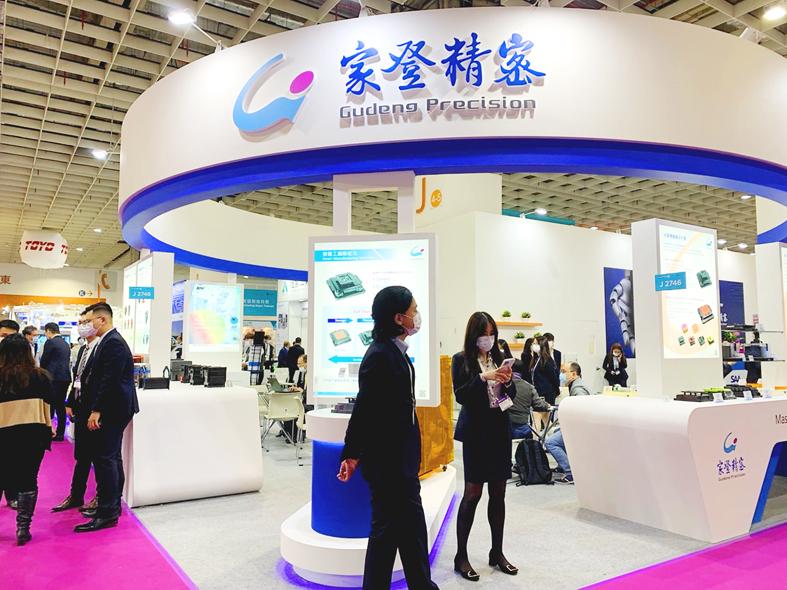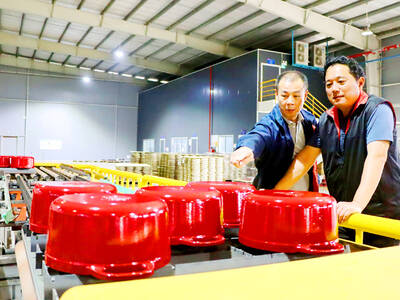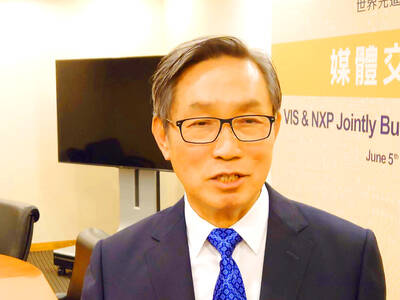Gudeng Precision Industrial Co (家登), the sole supplier of extreme ultraviolet (EUV) pods to Taiwan Semiconductor Manufacturing Co (TSMC, 台積電), yesterday said it is looking at setting up a factory in the US to align itself with TSMC’s capacity expansion there.
Gudeng is one of several TSMC suppliers that are considering following their customer in setting up operations in the US to provide on-site services.
TSMC is building a 12-inch fab in Phoenix, Arizona, for an initial investment of US$12 billion. It plans to produce 20,000 wafers a month using 5-nanometer technology when the fab becomes operational in 2024.

Photo: Grace Hung, Taipei Times
TSMC uses EUV tools extensively in the production of chips using 5-nanometer technology and plans to use it to make 3-nanometer chips.
Gudeng chairman Bill Chiu (邱銘乾) told a media briefing in Taipei that the company is in no hurry to build a plant in the US, given the small scale of TSMC’s capacity expansion in the US at this stage.
TSMC’s Arizona fab is to have installed capacity of 20,000 wafers a month, which is only one-fifth of 100,000 wafers at TSMC’s advanced factories at home.
“However, it is only a matter of time for Gudeng to build a presence in the US,” Chiu said, adding that semiconductor production has become a national security issue, which might constitute a trade barrier.
Building a localized supply chain, rather than cost efficiency, has become the top priority for semiconductor companies when selecting new factory sites, as the COVID-19 pandemic has upended the normal production and supply of components and raw materials, Chiu said.
“This [building localized supply chains] will be the top priority for us in the next three to five years,” he said.
Gudeng is looking to form an alliance with local semiconductor equipment manufacturers and raw material suppliers to minimize the risk of supply disruptions, Chiu said.
Before it builds capacity in the US, Gudeng is arranging several of its employees to work at its US office to provide on-site services to customers, Chiu said.
The employees are waiting for their working visa applications to be approved, he said.
Gudeng controls about 70 percent of the world’s EUV pod market, with TSMC and Intel Corp topping its customer list.
TSMC, Intel and Samsung Electronics Co are the world’s only three semiconductor companies that can afford the expensive EUV tools made by ASML Holding NV.
China is also trying to enter the advanced chip manufacturing market via Huawei Technologies Inc (華為), an industry insider said.
Huawei wants Gudeng to build a production line in China to back a chip manufacturing fab, the person said.
Gudeng yesterday gave an optimistic outlook for next year, thanks to strong demand for EUV pods and wafer front opening unified pods (FOUPs).
Gudeng said it has landed a big order to supply wafer FOUPs to the nation’s biggest semiconductor company next year and expects demand for EUV pods to rise rapidly after TSMC starts ramping up 3-nanometer technology in the second half of next year.
During the first 11 months of this year, Gudeng’s revenue surged 26.54 percent to NT$2.72 billion (US$98.24 million), compared with NT$2.15 billion in the same period last year.

TAKING STOCK: A Taiwanese cookware firm in Vietnam urged customers to assess inventory or place orders early so shipments can reach the US while tariffs are paused Taiwanese businesses in Vietnam are exploring alternatives after the White House imposed a 46 percent import duty on Vietnamese goods, following US President Donald Trump’s announcement of “reciprocal” tariffs on the US’ trading partners. Lo Shih-liang (羅世良), chairman of Brico Industry Co (裕茂工業), a Taiwanese company that manufactures cast iron cookware and stove components in Vietnam, said that more than 40 percent of his business was tied to the US market, describing the constant US policy shifts as an emotional roller coaster. “I work during the day and stay up all night watching the news. I’ve been following US news until 3am

UNCERTAINTY: Innolux activated a stringent supply chain management mechanism, as it did during the COVID-19 pandemic, to ensure optimal inventory levels for customers Flat-panel display makers AUO Corp (友達) and Innolux Corp (群創) yesterday said that about 12 to 20 percent of their display business is at risk of potential US tariffs and that they would relocate production or shipment destinations to mitigate the levies’ effects. US tariffs would have a direct impact of US$200 million on AUO’s revenue, company chairman Paul Peng (彭雙浪) told reporters on the sidelines of the Touch Taiwan trade show in Taipei yesterday. That would make up about 12 percent of the company’s overall revenue. To cope with the tariff uncertainty, AUO plans to allocate its production to manufacturing facilities in

Six years ago, LVMH’s billionaire CEO Bernard Arnault and US President Donald Trump cut the blue ribbon on a factory in rural Texas that would make designer handbags for Louis Vuitton, one of the world’s best-known luxury brands. However, since the high-profile opening, the factory has faced a host of problems limiting production, 11 former Louis Vuitton employees said. The site has consistently ranked among the worst-performing for Louis Vuitton globally, “significantly” underperforming other facilities, said three former Louis Vuitton workers and a senior industry source, who cited internal rankings shared with staff. The plant’s problems — which have not

TARIFF CONCERNS: The chipmaker cited global uncertainty from US tariffs and a weakening economic outlook, but said its Singapore expansion remains on track Vanguard International Semiconductor Corp (世界先進), a foundry service provider specializing in producing power management and display driver chips, yesterday withdrew its full-year revenue projection of moderate growth for this year, as escalating US tariff tensions raised uncertainty and concern about a potential economic recession. The Hsinchu-based chipmaker in February said revenues this year would grow mildly from last year based on improving supply chain inventory levels and market demand. At the time, it also anticipated gradual quarter revenue growth. However, the US’ sweeping tariff policy has upended the industry’s supply chains and weakened economic prospects for the world economy, it said. “Now